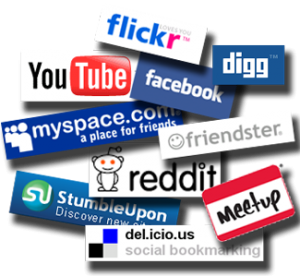5 Ways to Use Social Media in Med School
 Our generation is living in an age of social media, where communication is getting ever easier and learning has expanded beyond the books. With the advent of social media platforms like Facebook and YouTube, we’re finding more and more ways to use social media to ease and enhance our learning experience. As a med student, here are 5 ways I’ve used social media to enhance my medical educational experience:
Our generation is living in an age of social media, where communication is getting ever easier and learning has expanded beyond the books. With the advent of social media platforms like Facebook and YouTube, we’re finding more and more ways to use social media to ease and enhance our learning experience. As a med student, here are 5 ways I’ve used social media to enhance my medical educational experience:
1. Studying with a group over Google Plus’ Hangout feature – While the experience from digital interaction will never be as good as the experience from direct human interaction, it is much better than no interaction. During the time between fifth semester and the Step I at AUC, students often either stay on the island to study, take a review course somewhere, or go back home to the states or Canada to study. For those of us who choose this way, but who still want to study with our study partners from the island, Google Plus’s Hangout feature is the next best option. In my case, three friends and I got together everyday for 5 weeks to study. One was in Chicago, another was in Oklahoma, and two of us were in Florida. As far as I know, Google Plus’ Hangout feature is the only videoconferencing platform out on the web that is absolutely free, that can conference up to 10 people at the same time over video. In addition, you can write things and draw things and watch YouTube videos together in the Hangout, but as med students, we haven’t really used these features much (even though I do see its potential). For 4 people, the speed is fast and when we study it’s as if we’re in the same room.
2. Discussing topics from class on Facebook groups – Each entering semester class at AUC has its own group on Facebook. Before school starts, the groups are used as a forum to get information and advice on preparing for the journey to med school as well as to meet classmates, find roommates, and buy and sell things. After school starts, the groups transform into a forum where students organize group activities, ask questions, and discuss different topics from class, as most everyone in the group take the same classes. People posted links to study guides they’ve created or found, and help each other out in understanding the material. While AUC has always had the ANGEL Learning Platform for “official” academic forums and Q&A’s between students and faculty in class, ANGEL has always been underused for this purpose in my experience both by students and faculty alike. In practice, the recent Facebook groups have taken up these much-needed functions as they are much more accessible to students and already have a well-established community of users.
3. Read about patient experiences on Blogs – While as aspiring physicians we are learning how to treat disease, ultimately we must learn how to treat people. Reading the first-hand blog account of a patient who is fighting breast cancer gives us much insight and empathy into what it is like to be that person, and it will affect our bedside manners, our greater understanding of the disease, and our passion for what we do. In addition, reading the blogs of med students or residents is a great way to learn what to expect in the future and get advice. Or if you are a blogger, you can write about all the cool things you learned in class. You know you understand something when you can write about it or explain it to a complete stranger.
4. YouTube a disease — Ever wondered what the Parkinsonian tremor you learned about in class actually looks like in real life? Or if squirting cold water in your ear actually causes nystagmus of the eyes to the opposite side ? You can find it all on YouTube. Seeing a video of a patient with a condition has given me a greater insight about the things I learn about in class, putting disorders and diseases in the context of real people who have real lives and loved ones. Some of these videos are quite moving, as they are made by loved ones, organizations, or communities of patients and their families. It makes studying much more interesting, more memorable, and has opened me up to what’s out there concerning the conditions I’ve been learning about.
5. Get Twitter updates on the latest medical news – If you’re the type of person who likes getting short, fast, and instant updates, then Twitter is for you. Twitter is a microblogging platform in which users can update their statuses and share links to whoever subscribes to them, wherever and whenever. It’s a great way to keep up with the latest medical literature or news, such as that from JAMA, AMSA, or the New England Journal of Medicine.
Social media platforms have already moved beyond the personal realm to become a part of the professional world. Most major organizations and schools, including AUC, have their own Twitter, Youtube, and Facebook streams. Other schools such as Stanford or Medical College of Georgia even have their own podcasts, streaming lectures about various health or medical topics to the world, for free. Whether or not you participate in social media, it is becoming a greater and more visible part of our society, and certainly for school as well.













This is a great list Benji. I’ll definitely try out the youtube one soon.